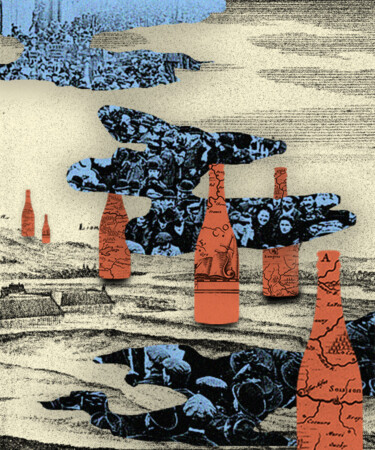Vibrant, vivacious, and lush, nothing feels quite as chic and elegant as a glass of chilled Champagne. While it’s difficult today to imagine a world without the French bubbly, there was a time when this nightmare was a near-reality after a treacherous combination of vine-eating pests, horrific weather, and poor government regulations resulted in passionate — and sometimes violent — uprisings. In 1911, in response to low crop yields and Champagne producers who had begun sourcing grapes from outside the region, grape growers took to the streets in protests that lasted some 16 years.
To understand the roots of the rioting, it is first important to recognize the interconnected relationship between growers and producers in the Champagne region. By the start of the 20th century, the cost of producing Champagne had grown exponentially, and many growers could not afford to produce wines themselves. As such, large Champagne houses — with their mass amounts of capital — quickly established a monopoly. The livelihood of smaller Champagne growers was quickly relegated to the Champagne houses that decided to purchase their grapes.
While a similar system of Champagne producers sourcing from growers outside their houses is still in place today — and regulated thanks to the strict guidelines proposed by the region’s appellation — in 1911, these appellation guidelines had yet to be established, meaning there was nothing preventing producers from sourcing grapes outside of Champagne. Prior to the outbreak of the riots, the Champagne region had struggled immensely for over a decade due to an onslaught of phylloxera and poor weather conditions severely reducing crop yields.
Phylloxera — small insects that attack grapevines — had destroyed thousands of acres of vines, with over 15,000 acres perishing in 1910 alone. As growers struggled to contain the spread of phylloxera in their vineyards, a period of late frosts and torrential rain caused the grapes to develop mold and mildew, reducing crop yields even further from 1902–1909.
As grapes in Champagne continued to dwindle, producers — taking advantage of the lack of appellation guidelines — began importing grapes from around the world while still labeling the resulting wines as Champagne. The practice caused Champagne grape growers’ sales to drop and plunged a number of independent growers into poverty. Desperate to retain some of Champagne’s prestige and reduce competition, growers petitioned the government to mandate that 51 percent of all grapes used in wines labeled as Champagne be grown in the Champagne region.
In 1908, the French government, heeding the growers’ requests, delineated the regions of France that would constitute Champagne: the Aisne and Marne districts. The decree notably excluded the district of Aube — home to the town of Troyes, the historic capital of Champagne — after lobbying from large Champagne houses in Marne classified Aube’s wine as “second-class Champagne.” The alienation of Aube from Champagne’s appellation rightfully ruffled the feathers of the region’s growers, exacerbating ever-increasing tensions from low-crop yields. Champagne’s vineyards were further assaulted in 1910 after a series of hail storms destroyed all but 4 percent of the year’s total yield and served as a tipping point for the growers, who were tired of suffering at the hands of producers.
In January 1911, Champagne growers took their frustrations to the streets, hijacking imported shipments of wine and grapes and dumping them into the Marne river. Rioters also took to burning the cellars and vineyards of any Champagne house they suspected of importing product, as well as other private businesses and homes. By April, news of the riots had spread around the world, with Australian newspaper The Advertiser reporting that the destruction in Champagne “probably would have been greater had not the straw used to start the fires been saturated with spirits of wine.”
Beyond fighting for better treatment from producers, rioters in Aube also sought for their region to be included in Champagne’s delineation while those in Marne grappled for the exact opposite, hoping to instead maintain their elite status. “The winegrowers, fearing the loss of their privileged monopoly, rose as one man,” The Advertiser reported. “Their fury was directed against firms in Aÿ and Epernay who were accused of importing grapes from beyond the delimited area for Champagne making, or wines from Aube for the purpose of blending it with the products of Marne.”
Aÿ, home to the most houses in Champagne, suffered the worst of the violence, with wineries and private residences alike ransacked and set aflame. The French government sent in 40,000 troops to oversee and quell the situation in Aÿ, but protests continued until the outbreak of World War I in 1914. While the war halted any meaningful talks about improving the situation in Champagne, the region’s viticultural boundaries were redefined in 1927 to include the districts of Aube, Côte de Blancs, Côte de Sézanne, Montagne de Reims, and Vallée de la Marne in response to the years of unrest.
Not only did growers achieve their goal of delineating exactly what could be called Champagne; the riots helped the French government to develop the Appellation d’Origine Contrôlée that is still in place today.
